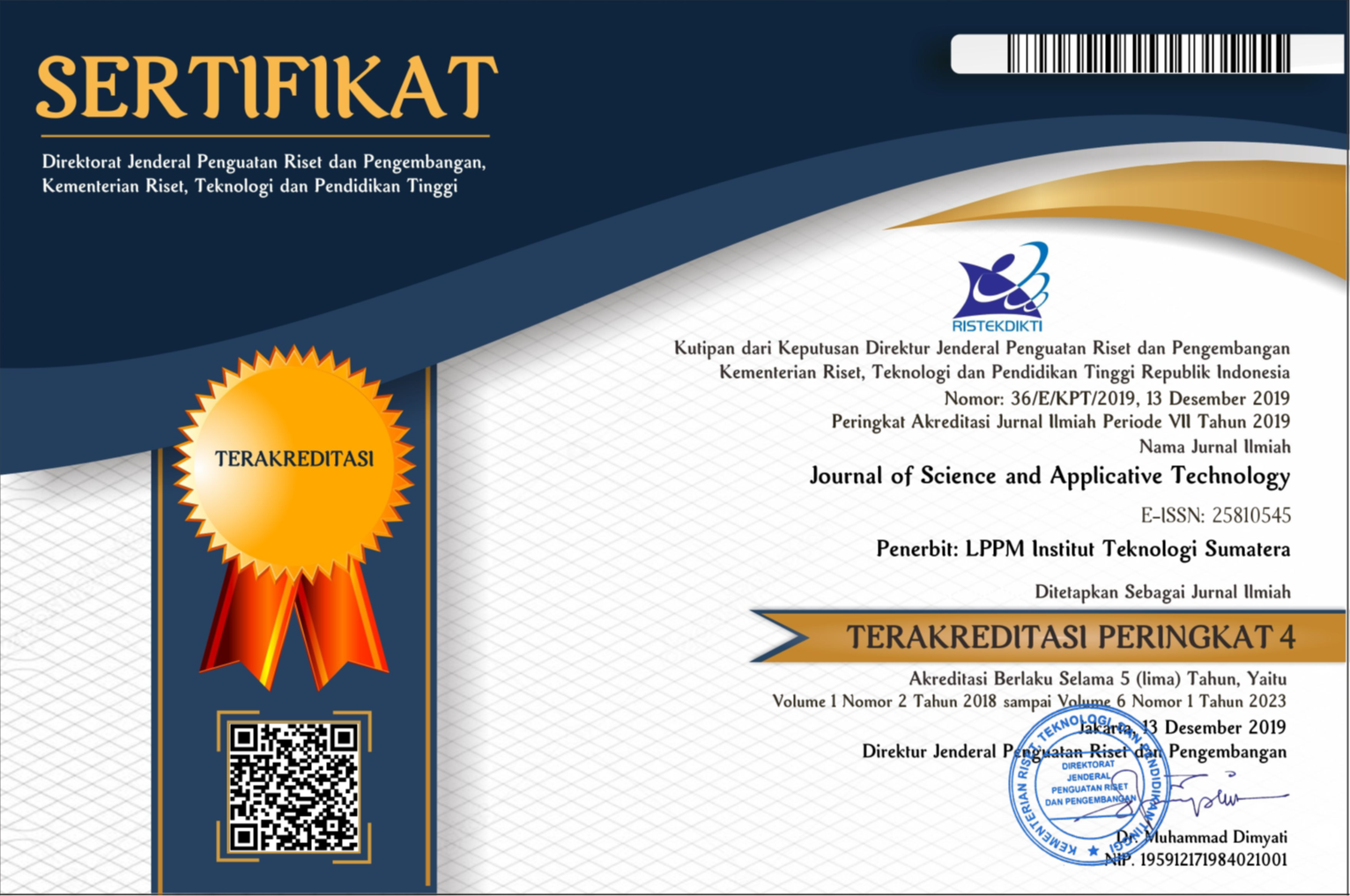Pengembangan Pengontrol Tegangan Sistem Mikrogrid Cerdas Menggunakan Sistem Baterai Penyimpan Energi
Abstract
A power outage on a conventional grid can cut the electricity supply to the entire load. In contrast, Microgrid (MG) can still supply at least the most critical local loads even though blackout occurs in the main grid. MG can also utilize renewable energy sources such as solar and wind energy to generate electricity. That is possible by the advancement of the battery energy storage system (BESS). The BESS able to maintains electricity supply to the load even in outages. The inverter on the SBPE also plays a role in stabilizing the MG output voltage by supplying or absorbing reactive power in the MG system. This paper focuses on the control development of the battery inverter primary controller. The droop control design utilizes the deadband around the nominal voltage. That becomes the improvement of the droop control method used in this study compared to the initial formulation of the droop method. The proposed method was then tested through simulation with four different scenarios. The BESS will operate in the voltage range 194.9V to 234.6V with a droop control deadband in the voltage range 198.0V to 231.0V. Based on the simulation results, the addition of SBPE with the MG scheme on the existing system can improve the quality of the voltage received by the load from 0.994p.u. to 0.997p.u. The simulation also shows that the load still gets a power supply even though there is a blackout on the main grid.
Downloads
References
[2] J. Hu, Y. Shan, J. M. Guerrero, A. Ioinovici, K. W. Chan, and J. Rodriguez, “Model predictive control of microgrids – An overview,” Renew. Sustain. Energy Rev., vol. 136, p. 110422, 2021, doi: https://doi.org/10.1016/j.rser.2020.110422.
[3] E. Kuznetsova, Y.-F. Li, C. Ruiz, E. Zio, G. Ault, and K. Bell, “Reinforcement learning for microgrid energy management,” Energy, vol. 59, pp. 133–146, 2013, doi: https://doi.org/10.1016/j.energy.2013.05.060.
[4] I. Novickij and G. Joós, “Model Predictive Control Based Approach for Microgrid Energy Management,” in 2019 IEEE Canadian Conference of Electrical and Computer Engineering (CCECE), 2019, pp. 1–4, doi: 10.1109/CCECE.2019.8861781.
[5] Kementrian ESDM, “Indonesia Energy Outlook 2019,” Jakarta, 2019.
[6] A. U. Rehman, S. Zeb, H. U. Khan, S. S. U. Shah, and A. Ullah, “Design and operation of microgrid with renewable energy sources and energy storage system: A case study,” in 2017 IEEE 3rd International Conference on Engineering Technologies and Social Sciences (ICETSS), 2017, pp. 1–6, doi: 10.1109/ICETSS.2017.8324151.
[7] P. Buason, H. Choi, A. Valdes, and H. J. Liu, “Cyber-Physical Systems of Microgrids for Electrical Grid Resiliency,” in 2019 IEEE International Conference on Industrial Cyber Physical Systems (ICPS), 2019, pp. 492–497, doi: 10.1109/ICPHYS.2019.8780336.
[8] A. Hussain, V.-H. Bui, and H.-M. Kim, “Microgrids as a resilience resource and strategies used by microgrids for enhancing resilience,” Appl. Energy, vol. 240, pp. 56–72, 2019, doi: https://doi.org/10.1016/j.apenergy.2019.02.055.
[9] M. Uslar et al., “Applying the Smart Grid Architecture Model for Designing and Validating System-of-Systems in the Power and Energy Domain: A European Perspective,” Energies , vol. 12, no. 2. 2019, doi: 10.3390/en12020258.
[10] M. Mazidi, N. Rezaei, F. J. Ardakani, M. Mohiti, and J. M. Guerrero, “A hierarchical energy management system for islanded multi-microgrid clusters considering frequency security constraints,” Int. J. Electr. Power Energy Syst., vol. 121, p. 106134, 2020, doi: https://doi.org/10.1016/j.ijepes.2020.106134.
[11] X. Feng, A. Shekhar, F. Yang, R. E. Hebner, and P. Bauer, “Comparison of Hierarchical Control and Distributed Control for Microgrid,” Electr. Power Components Syst., vol. 45, no. 10, pp. 1043–1056, Jun. 2017, doi: 10.1080/15325008.2017.1318982.
[12] Y. Hua, X. Shentu, Q. Xie, and Y. Ding, “Voltage/Frequency Deviations Control via Distributed Battery Energy Storage System Considering State of Charge,” Appl. Sci., vol. 9, no. 6, p. 1148, Mar. 2019, doi: 10.3390/app9061148.
[13] J. M. Guerrero, J. C. Vasquez, J. Matas, L. G. de Vicuna, and M. Castilla, “Hierarchical Control of Droop-Controlled AC and DC Microgrids—A General Approach Toward Standardization,” IEEE Trans. Ind. Electron., vol. 58, no. 1, pp. 158–172, 2011, doi: 10.1109/TIE.2010.2066534.
[14] G. Kim, W.; Song, S.; Jang, “Droop Control Strategy of Utility-Scale Photovoltaic Systems Using Adaptive Dead Band,” Appl. Sci., vol. 10, no. 8032, 2020.
[15] P. Tugarinov, F. Truckenmüller, and B. Nold, “Digital twin of distributed energy devices,” in Forum hirnykiv. Materialy mižnarodnoï konferenciï, 26-27 veresnja 2019 r, 2019, pp. 323–331, [Online]. Available: https://publikationen.reutlingen-university.de/frontdoor/index/index/docId/2629.
[16] L. D. P. Ospina, A. F. Correa, and G. Lammert, “Implementation and validation of the Nordic test system in DIgSILENT PowerFactory,” in 2017 IEEE Manchester PowerTech, 2017, pp. 1–6, doi: 10.1109/PTC.2017.7980933.
[17] G. Lammert, L. D. P. Ospina, P. Pourbeik, D. Fetzer, and M. Braun, “Implementation and validation of WECC generic photovoltaic system models in DIgSILENT PowerFactory,” in 2016 IEEE Power and Energy Society General Meeting (PESGM), 2016, pp. 1–5, doi: 10.1109/PESGM.2016.7741608.
[18] H.-A. Park, G. Byeon, W. Son, H.-C. Jo, J. Kim, and S. Kim, “Digital Twin for Operation of Microgrid: Optimal Scheduling in Virtual Space of Digital Twin,” Energies, vol. 13, no. 20, p. 5504, Oct. 2020, doi: 10.3390/en13205504.
[19] I. Nashirul Haq, D. Kurniadi, E. Leksono, B. Yuliarto, and F. X. N. Soelami, “Performance Analysis of Energy Storage in Smart Microgrid Based on Historical Data of Individual Battery Temperature and Voltage Changes,” J. Eng. Technol. Sci., vol. 51, p. 149, Apr. 2019, doi: 10.5614/j.eng.technol.sci.2019.51.2.1.
[20] Kementrian ESDM, Peraturan Menteri Energi dan Sumber Daya Mineral No. 3 Tahun 2007 Tentang Aturan Sistem Tenaga Listrik Jawa-Madura-Bali. 2007.
Copyright (c) 2022 Journal of Science and Applicative Technology

This work is licensed under a Creative Commons Attribution-NonCommercial 4.0 International License.
All the content on Journal of Science and Applicative Technology (JSAT) may be used under the terms of the Creative Commons Attribution-NonCommercial 4.0 International License.
You are free to:
- Share - copy and redistribute the material in any medium or format
- Adapt - remix, transform, and build upon the material
Under the following terms:
- Attribution - You must give appropriate credit, provide a link to the license, and indicate if changes were made. You may do so in any reasonable manner, but not in any way that suggests the licensor endorses you or your use.
- NonCommercial - You may not use the material for commercial purposes.
- No additional restrictions - You may not apply legal terms or technological measures that legally restrict others from doing anything the license permits.





















